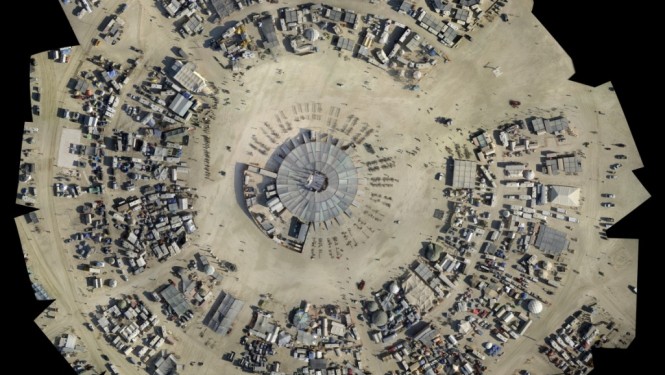[Andrew Johnstone is an artist, muralist, 3D computer designer and enthusiastic geomapper. He was the creator of the first 3D fly-through simulation of Black Rock City (originally using Microsoft Flight Simulator software), and he crafts the 3D models of the Man and Man base found on the Burning Man website. He has been the Project Lead of the Burning Man Earth Project since its inception in 2005. This post is part of the Metropol Blog Series.]
In 2005, our city designer, Rod Garrett, saw Black Rock City as the perfect Petri dish for technological experiments in geographic data and digital inter-connection. He began to assemble an exceptional international team of creative innovators and programmers, and formed the Burning Man Earth Project.

This volunteer team designed mapping and communication tools to enable Burning Man attendees to better locate themselves and others within the city, to communicate within the area, and to access and contribute information about artworks and events. The project was aimed at providing a managed digital space to encompass all of the physical facets of the Burning Man experience, both in real-time functionality and as a permanent archive.
It was imagined that this work also had implications beyond the limits of Black Rock City. These tools of “where enabling” would have application for populations isolated by natural disasters, refugee camps, or other devastations. The remoteness of the Burning Man event provides an ideal opportunity to test and adapt our programming into proven solutions for disaster relief. And as it is completely open-sourced, others are able to use and build upon it.

Before we knew it, our software and experience in this field found its first real-world application. It was employed at the Haiti earthquake site by two of our lead programmers, Jeffrey Johnson and Mikel Maron. They were summoned to join an international team (including NASA, the UN, World Bank, Google, and more) to provide crucial solutions to the mapping of people and locations, services, communications, etc. From this, our work at Burning Man will be incorporated into a coordinated international effort to build software and communication solutions which more effectively serve the victims of disaster.

In an allied effort, Mikel (who in “real life” is part of the Open Street Map organization) is now in Kenya working on Map Kibera, a humanitarian effort to map the pathways and alleys of Africa’s largest slum. Without a basic knowledge of their geography and resources, even informed discussion about improving the people’s lives is impossible. Mapping and communications are vital to their very lives.
In 2009, part of our high resolution aerial survey of Black Rock City included some jaw-dropping <2cm aerial imagery (due to size it’s very slow to appear on the black screen, but then zoom) taken from a tethered balloon rig. These images were shot by Jack Alderson and then processed and stitched by Stewart Long, both part of the team.
On April 11th, the Deepwater Horizons oil rig exploded and toppled into the Gulf of Mexico. Stuart was quickly flown to the barrier islands off Louisiana as part of the Grassroots Mapping Project, where he used equipment designed specifically for our ephemeral city to take ultra hi-res imagery to document the spill for the cleanup efforts. The data resulting from the balloon-mounted cameras is 100x better than conventional satellite imagery, at a fraction of the cost. Stuart taught locals from the Louisiana Bucket Brigade how to build and fly their own rigs to continue the work, and form a comprehensive backbone of record. He left Burning Man Earth equipment and cameras with them, just to keep it all rolling.

As Earth itself seems slowly transforming into an interconnected metropolis, we must increasingly accept responsibility. The Burning Man Earth Project demonstrates another instance where the skills and spirit shared through the Burning Man experience carries out, adding human value to the “default” world.
[If you’d like to learn more and donate to the Humanitarian OpenStreetMap Team, visit their website.]


http://gigapan.org/gigapans/50074/
Report comment
Comments are closed.